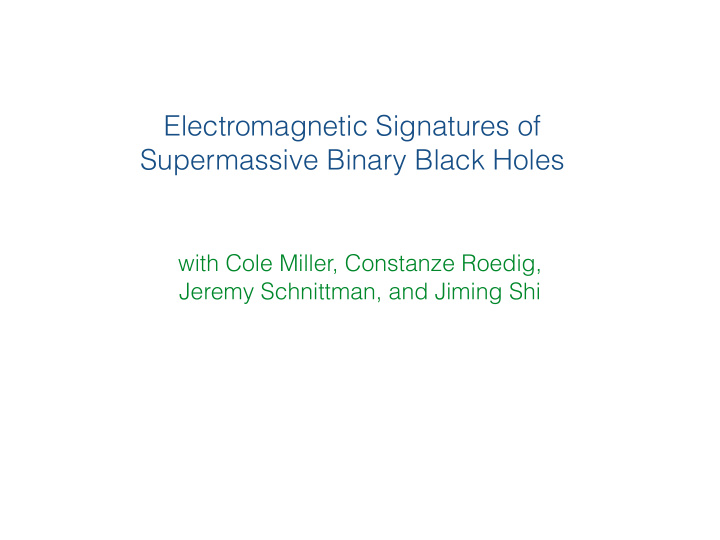



Electromagnetic Signatures of Supermassive Binary Black Holes with Cole Miller, Constanze Roedig, Jeremy Schnittman, and Jiming Shi
Desirable Targets Direct indicator of major galaxy mergers Illustrate process of supermassive black hole growth Run-up to black hole merger, maybe early warning
But Frustratingly Hard to Find LISA (or eLISA, iLISA, LISA-light, ….) not any time soon Lots of photon telescopes available now, but….
What Distinguishes SMBBH from AGN? Continuum modulation on orbital period? But most light from near-ISCO region of “mini-disks”, and t inflow >> P orb until separation quite small ( but see counter-example later) Split broad-line profiles? But BLR shared by BHs when v orb >> v BLR , while BLR profiles merge when v orb << v BLR
Two Potentially Better Possibilities: • Spectral contrasts • Pulsar timing
Accretion through Prograde Circumbinary Disks A brief history of ~0 analytic (Pringle 1991) ~0.1 2-d α hydro (Milosavljevic & MacFadyen 2008) ~0.3 3-d MHD (Shi et al. 2012) 0.05 ~1 2-d α hydro (Farris et al. 2014) q = 0 ~1 3-d MHD (Shi & K. 2015) q = 0.1 0.04 dM / dt ((GMa) 1/2 Σ 0 ) q = 1 0.03 0.02 0.01 0.00 1000 1100 1200 1300 1400 1500 − 1 ) t ( Ω bin
Accretion Streams across the Gap Prograde q ~ O(1) circumbinary disks have gaps crossed by accretion streams q=1 q=0.1
Stream orbits are almost constant-energy, laminar, ballistic; i.e., little orbital energy dissipated into heat. Inflow speed >> turbulent speed —> stretched field lines, little heat production. And initial heat radiated quickly: —> Little radiation from the streams
“Notches” ( Roedig, K & Miller 2014 ) See partial accounts in Roedig et al. 2012, Tanaka et al. 2012, Gultekin & Miller 2012, Kocsis et al. 2012, Tanaka & Haiman 2013, Tanaka 2013; also Farris et al. 2015 Absence of thermally-radiating material removes spectrum for a factor ~3 on either side of single black hole q=0.3 q=1 q=0.1 Notch falls in middle of visible band for
( Roedig, K & Miller 2014 ) Hard X-ray Bumps Accretion streams join “mini-disks” around each black hole, with majority of accretion going to the secondary Streams shock at edges of “mini-disks” with high temperature assuming circular orbits, as GW likely enforces But cool quickly and brightly
Very Hard X-ray Components q=1, fiducial parameters Expect modulation on the binary orbital period to the extent that accretion is modulated
Two Better Possibilities: • Spectral contrasts • Pulsar timing
Pulsar Timing Arrays and Black Hole Binaries Expect a diffuse gravitational wave background from the Universe’s supermassive black hole binaries. Gravitational redshift at pulsar reflects local GW wave background; likewise at Earth: Observe pulsars in many directions over many years and constrain the fluctuation power on year/multi-year timescales Low-eccentricity orbital evolution produces gravity wave spectrum dE/df ~ f -1/3
Retrograde Binaries Break the Rules Accretion of negative angular momentum rapidly increases binary eccentricity, decreases pericenter —> Pulsed gravitational wave emission when a is still so large little would be expected from a circular orbit Ultimately GW emission circularizes the orbit
Resulting Spectrum: (Schnittman & K 2015) Suppressed at P ~ few yr, enhanced at P ~ few months 10 14 10 13 standard 10 12 dE/df 10 11 fiducial 10 10 q=0.1 10 9 10 8 10 -9 10 -8 10 -7 10 -6 10 -5 f (Hz)
Retrograde May Be Generic Accreting only ~ 1/5 M 2 suffices to drive system to merger; orbital evolution due to prograde evolution several times slower Oblique retrograde alignment leads quickly to orbit flip to prograde, may not overcome that factor of 5
Conclusions • Prograde circumbinary disks should exhibit a “notch” in their thermal continua • They should also have a “bump” at ~ 100 keV that exceeds the intrinsic coronal emission when a < ~100 r g ; this bump should be modulated on the orbital period • Retrograde accretion pushes GW power from f < ~ 1 yr -1 to f > ~1 yr -1
Recommend
More recommend